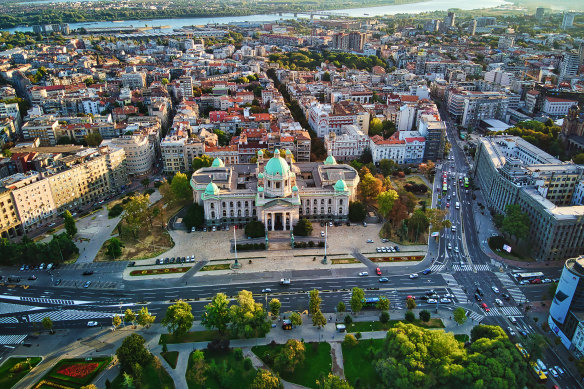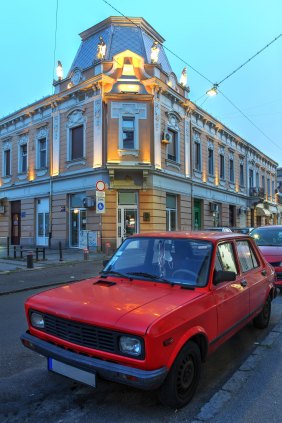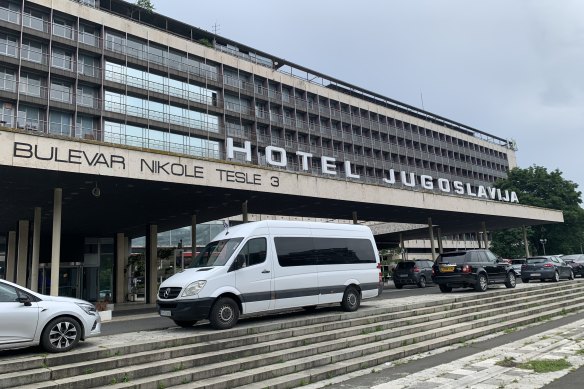The European country that disappeared in the ’90s still lingers here
By Tim Richards
Do things really go better with… Cockta?
I’m holding a bottle of this soft drink, bought from a service station in the Novi Beograd district of Belgrade, Serbia. Similar in colour to cola, it’s an amalgam of herbs, lemon juice and orange juice. It’s also a surviving relic of the former communist nation of Yugoslavia, having been invented in 1952 as an answer to Western soft drinks.

Sunrise over Belgrade, the city that was the administrative hub for the former Socialist Federal Republic of Yugoslavia. Credit: iStock
I take a sip and wince – the herbal flavour takes some getting used to – as I walk alongside Marija Miladinovic, my guide on a tour of the now-vanished Yugoslavia. We pause on the edge of a broad lawn to gaze at an impressive sprawl of white buildings between the road and the Danube River. It’s as close as we can approach for security reasons, says Marija, and indeed I can see a long line of police vehicles guarding its perimeter.
Known as the Palace of Serbia, this H-shaped government complex was once the Federal Executive Council, the administrative hub for the Socialist Federal Republic of Yugoslavia. Completed in 1959, it was the centrepiece of President Tito’s communist regime, breaking with the traditions of the monarchy it had replaced.
Viewed from a distance it’s an attractive building, covered with white marble from Brac Island in Croatia. The interior is bright and modernist, says my guide, with each country of the former federation having had its own specially decorated room. There was also a big nuclear shelter beneath, she adds.
What a pity we can’t see inside, but I am receiving a glimpse into the futurism that was part of socialist Yugoslavia. Not that the past could be entirely ignored; our first stop of the tour was the former Sajmiste fairgrounds, which became a concentration camp under Nazi occupation. Now, after decades in obscurity, one of its surviving towers is being turned into a memorial.
We return to our vehicle: a Yugo, another relic of the past. Sold locally as the Zastava, this was a “national car” with parts from each of the six Yugoslav republics. Launched in 1980 as a diminutive hatchback, it’s nowadays a focus of nostalgia.

A legendary Yugo on the streets of Belgrade.Credit: Alamy
With Marija at the wheel, the Yugo takes us to the Hotel Jugoslavija, a massive structure which opened in 1969. It’s hard to believe, but this weathered grey hulk was once extraordinarily stylish. Close to the executive buildings, it attracted international business and governmental guests and thus was a hotbed of intrigue.
“This place was full of spies,” Marija says, and there is indeed something of a Bond film about the interior. Its shopping and dining zone has been restored to its former glory, featuring a gleaming white staircase and a vast rectangular “chandelier” containing 40,000 Swarovski crystals. I feel like I should be wearing a snappy 1970s suit and broad paisley tie, on my way to a clandestine meeting with a contact.

Hotel Jugoslavija – the perfect setting for a spy movie? Credit: Tim Richards
There’s more startling architecture to come. First, the soaring brutalist 1979 Genex Tower with its defunct revolving restaurant (which never actually revolved) supported by twin towers; followed by the Museum of Yugoslavia, set in beautiful gardens.
As the main museum building is under renovation, Marija takes me instead to the adjacent House of Gifts, displaying presents given to President Tito. It’s an eclectic collection, including vases, musical instruments, traditional games and statuary. There’s also a selection of goods made in the former Yugoslavia, from the everyday (radios, confectionery) to the esoteric (the defunct Internet domain .yu).
Nearby is the House of Flowers, where Tito was buried after his death in 1980. Not for him the indignity of being embalmed and put on display like Lenin in Moscow – instead he reposes under an elegant marble headstone in a room full of natural light.
With his death came the slow unravelling of Yugoslavia, split into its constituent parts in the 1990s, but its spirit still lingers in the streets of Belgrade.
The writer travelled courtesy of Eurail, and paid for a private tour.
THE DETAILS
FLY
Emirates and FlyDubai fly to Belgrade via Dubai. See emirates.com
STAY
Hotel Moskva is an elegant historic hotel with an atmospheric cafe. Rooms from €87 ($145) a night.
See hotelmoskva.rs
TOUR
The Rise and Fall of a Nation Tour costs €45. See yugotour.com
Sign up for the Traveller Deals newsletter
Get exclusive travel deals delivered straight to your inbox. Sign up now.